Why Nicola Sturgeon always sent for John Swinney
- Published
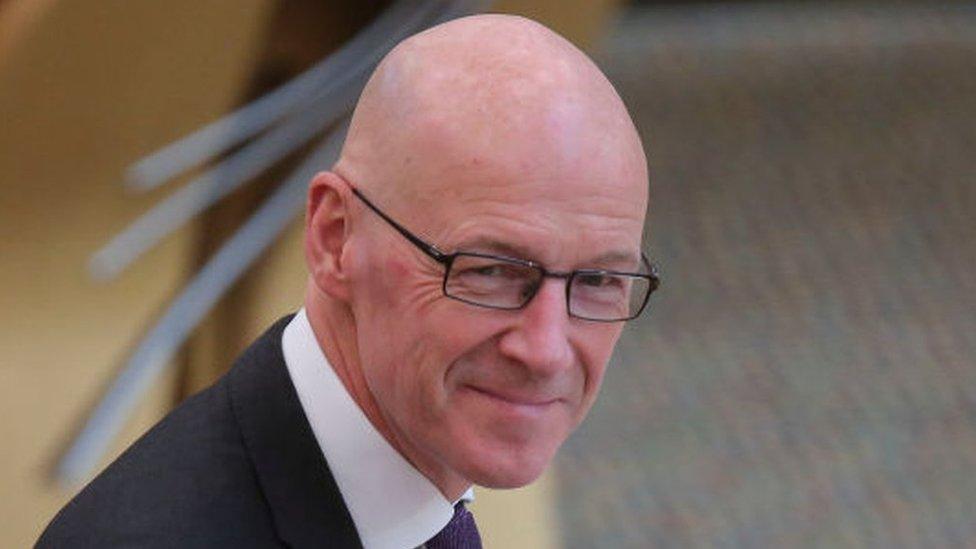
John Swinney has announced he is to leave the Scottish government after 16 years once a successor to Nicola Sturgeon is appointed.
The former SNP leader is Scotland's longest-serving deputy first minister, as well as being one of Ms Sturgeon's most trusted allies.
Most recently, he filled in for Kate Forbes as finance secretary when she was off on maternity leave.
His departure from government along with Ms Sturgeon later this month will signal the end of an era for both the SNP and Scottish politics.

Got a problem? Send for John Swinney.
That appeared to be Nicola Sturgeon's approach, anyway.
After the first minister announced closing the attainment gap in schools was her number one priority, he was made education secretary.
After she promised that helping the country bounce back from Covid was her top goal, guess who was made Covid recovery secretary?
And when a Holyrood inquiry started probing the government's botched handling of complaints against Alex Salmond - posing arguably the greatest threat Ms Sturgeon's leadership has faced - it was Mr Swinney who took the lead in defending her.
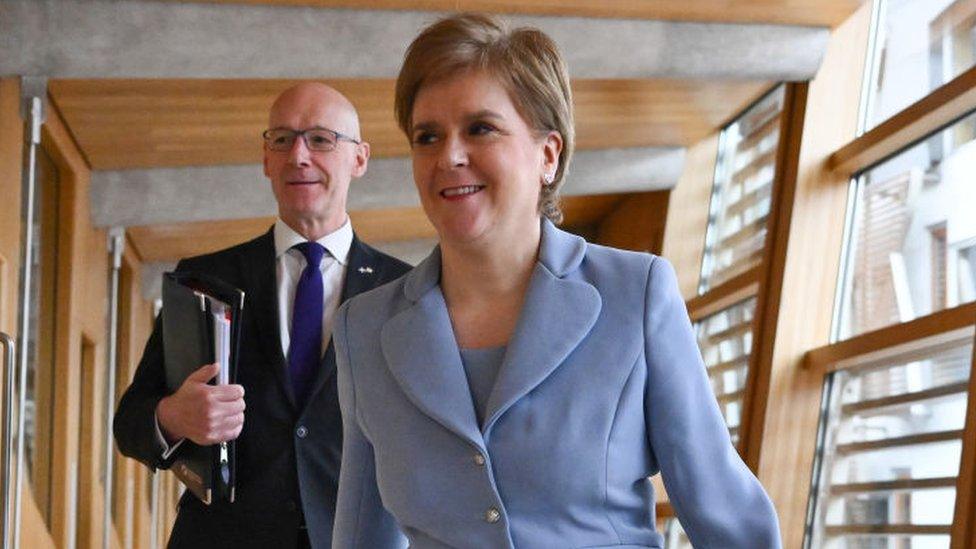
John Swinney has been an SNP stalwart for decades, having joined the party at the age of 15.
By the time he was 22 he was national secretary, and served in a series of increasingly senior roles before winning the North Tayside seat at Westminster in 1997.
Two years later he headed to Holyrood, and allowing for some boundary tweaks has represented the same patch of Perthshire ever since - one of only three MSPs with continuous service of one constituency since 1999.
Mr Swinney's rise through the ranks of the SNP was complete in 2000, when he was elected leader following the (first) departure of Alex Salmond.
He handily defeated Alex Neil in a leadership contest seen as a clash between the "gradualist" approach of using devolution to build towards a referendum, and the "fundamentalist" school which wanted to move more quickly towards independence.
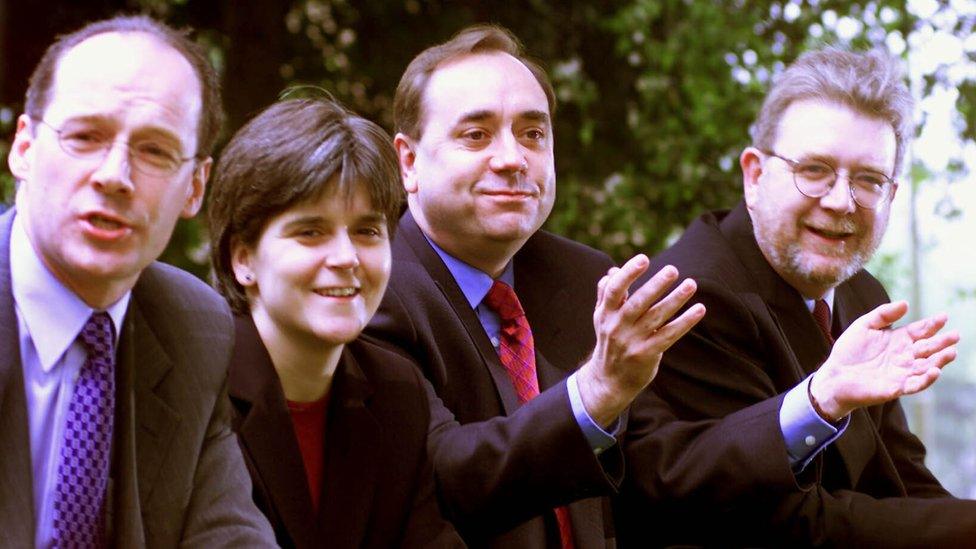
The key figures at the top of the SNP have been in place for more than 20 years
It is fascinating to look back on reports about the SNP from that period - even the picture above, from 1999, of Mr Swinney with Nicola Sturgeon, Alex Salmond and Mike Russell (now party president).
Mr Salmond's initial departure as leader the following year was pinned in part on a row over the SNP's finances, external, which featured a particular clash with one Ian Blackford - then party treasurer, more recently Westminster leader.
The core of the SNP's leadership was essentially unchanged for a run of 20 or even 30 years, over a period when Labour moved from Blair and Brown to Miliband, Corbyn and now Starmer - and went through even greater turmoil in Scotland.
The Conservatives are now on their seventh different leader since then, and have been through a similar whirlwind of internal ideological shifts.
Mr Swinney was part of a remarkably stable group during a remarkably turbulent period in Scottish and UK politics - but one that the SNP will now have to replace.
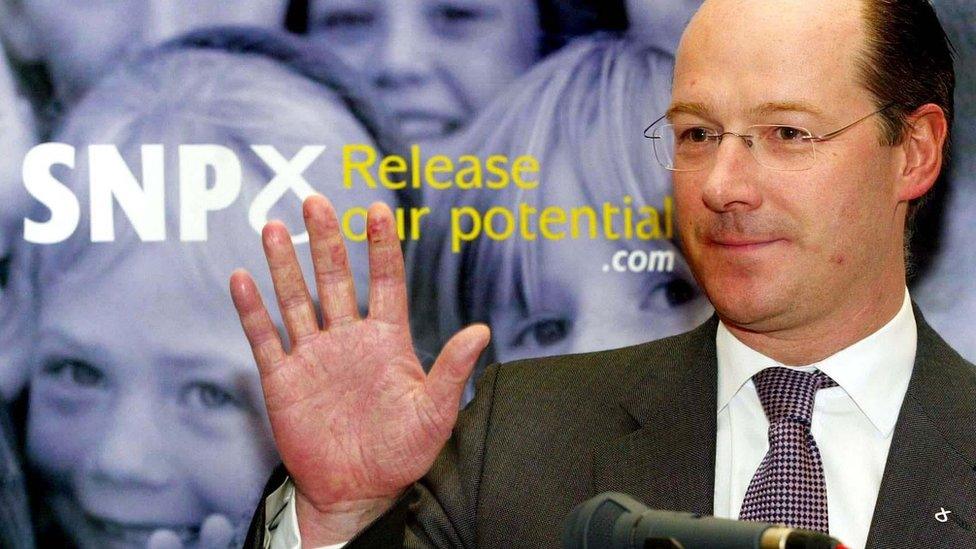
Mr Swinney had four years as SNP leader, in between Alex Salmond's two decade-long stints
Mr Swinney's own leadership of the SNP was a bit of a damp squib.
The party had 35 seats in the Scottish Parliament when he took over - firmly in second place but shut out of the Labour-Lib Dem administration - and six at Westminster.
On both fronts they went backwards in subsequent elections, losing one of the UK seats, external in 2001 and eight at Holyrood in 2003.
But it was the European Parliament elections of 2004 which prompted Mr Swinney's departure, despite the SNP retaining both of its seats.
He had survived a leadership challenge the previous year, but stepped down saying that the SNP was "not yet seen as an alternative government, external in waiting".

Mr Swinney managed to deliver budgets against the odds during the first Salmond government
This was not, apparently, the case for long. Alex Salmond swiftly took the SNP into government in 2007, and Mr Swinney was handed a key role - finance secretary.
The two men shared a goal of making the party more business-friendly while targeting votes in "middle Scotland", and this was make-or-break territory for the independence movement too.
It was crucial that the SNP could turn in a competent performance and run a steady ship in government if they were to convince Scots that Holyrood should take on the full powers of an independent state.
Mr Swinney had to get budgets through parliament despite sitting a long way short of a majority. In the first term he chiefly struck deals with the Conservatives - unthinkable today - but also found accord with the Greens and Liberal Democrats.
There was a notable crisis in 2009 when the budget fell at the first hurdle, but it got over the line at the second time of asking, external - with opposition leaders praising the finance secretary for engaging in "open and genuine discussion".

Mr Swinney is always one of the most popular speakers at SNP conferences
Mr Swinney kept the finance brief when Nicola Sturgeon moved into Bute House, as well as taking on the role of deputy first minister.
He led the protracted negotiations over the fiscal framework which paved the way for further powers to be devolved to Holyrood.
Ms Sturgeon claimed that her deputy "gubbed" the Treasury in those talks, although the deal is now painted in more muted colours as a scheduled review of it gets under way.
After the 2016 election Ms Sturgeon reshuffled her team, moving Mr Swinney to education.
That was of course the election where she said that closing the poverty-related attainment gap between schools was her top priority.
That was a tough ask, and it is a goal which has still not been delivered. There were also tough pay negotiations to be had with teachers, with a strike ballot threatened prior to an 11th-hour deal.
Confidence votes
Being in key positions frequently puts Mr Swinney in the opposition's firing line.
He narrowly survived a vote of no confidence over his handling of school exams during the pandemic, with a huge row over teacher assessments being downgraded and then reinstated.
And he faced a second confidence vote less than a year later, as MSPs pressed him to hand over government legal advice to the committee investigating the handling of complaints against Mr Salmond.
Those two votes were a key motivation for the SNP in doing a deal with the Scottish Greens after the 2021 election; they would no longer be forced into concessions by the opposition banding together.
The inquiry row was also another example of Mr Swinney's role as defender-in-chief for his boss. He took the lead on engaging with the committee and trying to fend off particularly invasive questions about Ms Sturgeon's role.
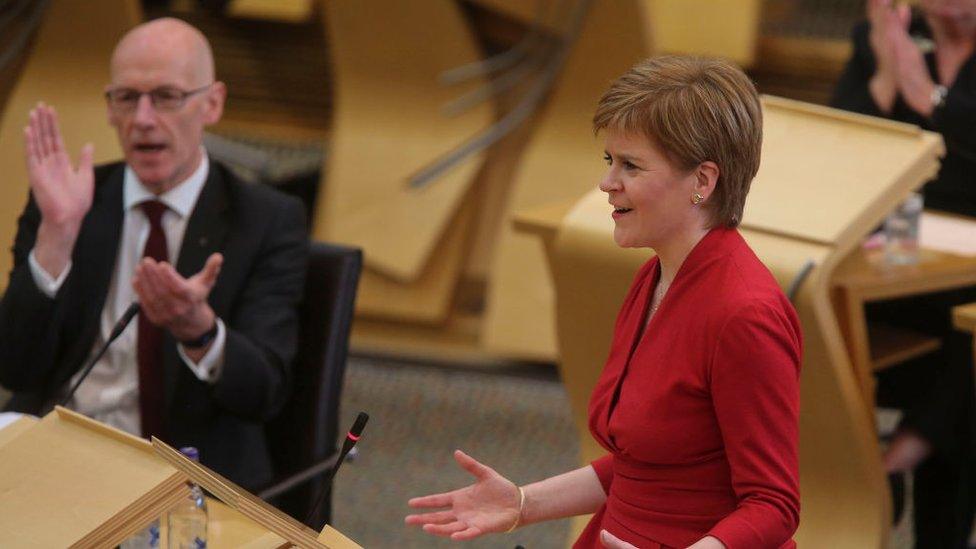
The deputy first minister is regularly audible during questions to the first minister
The same thing happened almost daily at Holyrood. You don't often see Mr Swinney during first minister's questions, but you can always hear him barking back at opposition leaders from the front bench.
And the deputy first minister is often the one sent out to deal with difficult issues on a day to day basis.
He is known in some circles as the Minister for Good Morning Scotland, given the frequency of his appearances on the radio.
While some politicians go into media engagements hoping to deliver a good line and generate a headline, Mr Swinney takes the exact opposite approach.
He has become a master of shutting down awkward subjects. His desert-dry delivery and careful choice of words leaves many lines of questioning becalmed.
But despite this - and indeed despite his unhappy tenure as party leader - Mr Swinney is regularly one of the most popular speakers at SNP conferences, rousing members with a thunderous delivery.
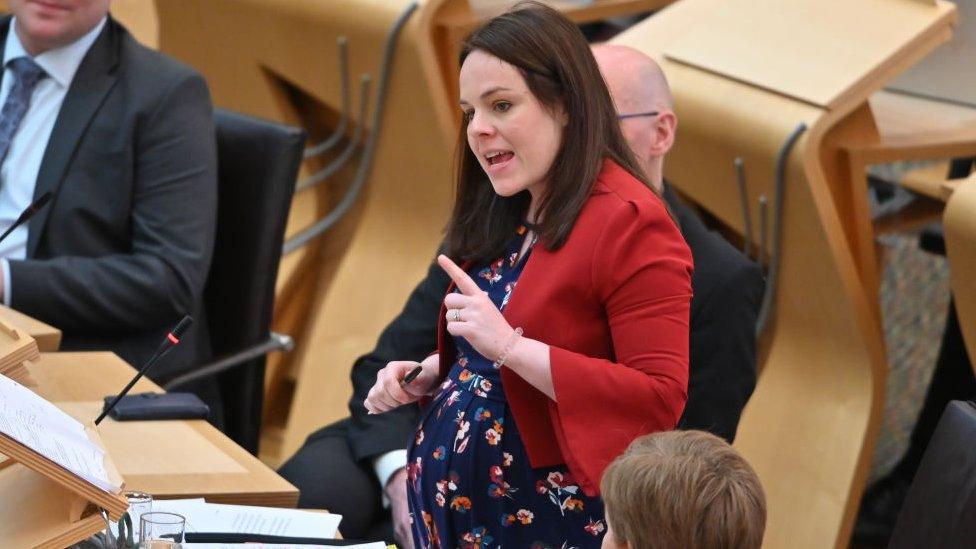
Kate Forbes will keep the finance secretary title while on maternity leave, but Mr Swinney is covering her duties
The pandemic redefined Nicola Sturgeon's leadership, and once again she called on Mr Swinney, shifting him to the post of Covid recovery secretary after the 2021 election.
There were questions over whether this represented a demotion from the education job, but there is no doubt that the first minister's deputy remains one of her most trusted lieutenants.
And his inner-circle status was underlined by the fact was asked to step once again into the finance brief to cover for Kate Forbes - one of the three candidates to replace Ms Sturgeon - when she went off on maternity leave.
The government was in a tight position financially. Most departments are facing real-terms budget cuts over the coming years, based on the forward-planning figures set out by Kate Forbes.
That is only exacerbated by sky-high inflation rates and the financial hangover from the pandemic, all while citizens badly need help with a cost of living crisis.
So it was perhaps little surprise that Ms Sturgeon opted to put the job back in the hands of her closest and most experienced political ally.
Now, the two of them will be heading to the back benches together. Between them they will take 50 years of parlimentary experience - something their replacements may struggle to replace.